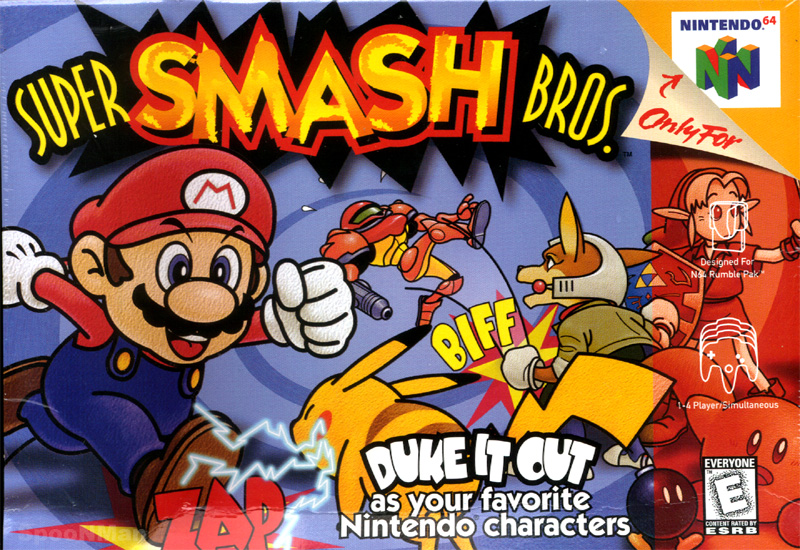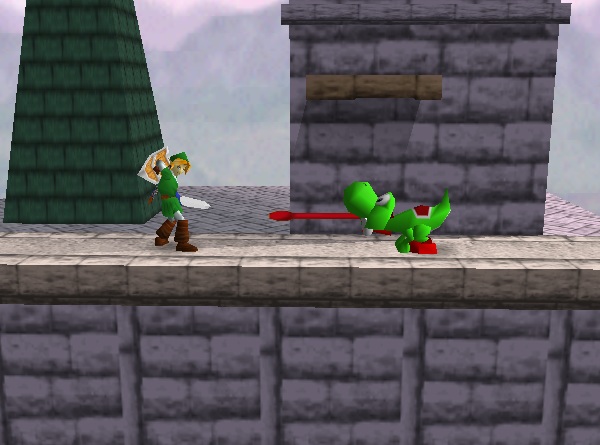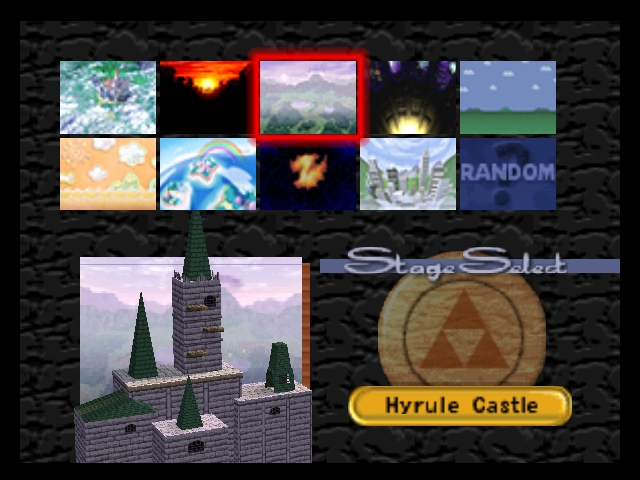Super Smash Bros.
Released: January 21, 1999
Super Smash Bros. , known in Japan as Nintendo All-Star! Dairanto Smash Brothers, is a crossover fighting video game developed by HAL Laboratory, Inc. and published by Nintendo for the Nintendo 64 console. It was first released in Japan on January 21, 1999, and releases on April 27, 1999 in North America and November 19, 1999 in Europe followed.
Players are able to choose from up to twelve characters (four of whom need to be unlocked) from various games in Nintendo's history, such as Mario, Link, Pikachu, and Kirby. In all the Smash Bros. titles, the characters appear to be toys or trophy figures representing Nintendo characters brought to life for the purpose of combat.
Super Smash Bros. is the first game in the Super Smash Bros. series. It was followed by the very successful Super Smash Bros. Melee for the Nintendo GameCube and the upcoming Super Smash Bros. Brawl for Wii.

Gameplay
Super Smash Bros. uses a battle system different from the average fighting game. Choosing from a variety of characters, two to four players fight on various different stages, all while trying to knock their opponents off the stage. Instead of using health bars like other fighting games, the game features percentage meters. At the beginning of the match, the meters start at zero percent. As the characters take damage, the percentage meter goes up, causing the characters to fly farther back each time when hit. When a character is knocked off the stage, they lose either a life or a point depending on the mode of play. The characters can attack each other with a variety of different fighting moves. Each character can perform an array of attacks when prompted with the press of a button in conjunction with a tilt of a control stick. In addition to basic attacks, such as punches and kicks, characters have access to more powerful smash attacks as well as three special character-specific moves.
There are nine playable stages: eight based on each of the starting characters (such as Princess Peach's Castle for Mario , Zebes for Samus and Sector Z for Fox ) and the unlockable Mushroom Kingdom. The stages are three dimensional (although players cannot move with depth, save for a few types of dodges) arenas that are mostly based on levels from the represented series of the game. They range from floating platforms (Donkey Kong's Jungle Japes for example) to stationary land stages (e.g. the Mushroom Kingdom). Each stage has a boundary that cannot be passed, or the character will be " KO'd ", thus losing a life. The characters can make use of a variety of weapons, ranging from projectiles to melee weapons. Each item has a different effect on the characters around it. Some heal a single character, while others hurt any character in its vicinity. Single items and crates and barrels, which often contain an assortment of items, fall onto the stage randomly throughout the battle.

Single player
The game's single player mode always follows the same series of opponents, although the player could choose from five difficulty levels. Bonus stages in the single player mode included a "Break the Targets" stage and a "Board the Platforms" stage - each of which was specialized for the player character - as well as a "Race to the Finish" stage, which was the same regardless of the player character. Also included in the game is a Training mode, where a single player could practice his or her skills in any of the playable stages, and practice areas for each of the character-specialized Break the Targets and Board the Platforms stages.
Multiplayer
In multiplayer mode up to four people can play, with the specific rules of each match predetermined by the players. In "Time Battles", each player can be knocked out an infinite number of times. When the predetermined fight-time is up, scores are determined by subtracting a player's TKOs from their KOs, and a winner is determined. If there is a tie, the contenders are returned to the fighting stage and given a large amount of damage, so as to quickly determine the winner. In "Stock Battles", each player can be knocked out a fixed amount of times, and there is no time limit. The winner is thus selected by process of elimination.
Team Battles of the stock and time modes are also selectable. These have the same rules as the above modes, but players instead choose their teams and work cooperatively to win as a team. When teams are activated, members of the same team color (red, blue, green) are unable to cause damage or flinch each other by direct combat. Friendly fire can be turned on in the options menu so that team members are actually able to damage each other. When the match is over, KO totals are added up for each member of a team and taken as a whole, and then a winning team is declared. In a team stock match, when one member of a team has lost the total allotted number of lives, they are permitted get a life from their partner, provided that their partner has more than one life left themselves.
In the regular game, there are nine stages playable in Versus mode - eight based on each of the starting characters (such as Princess Peach's Castle for Mario, Planet Zebes for Samus, Sector Z for Fox), and the unlockable Mushroom Kingdom stage.

Playable characters
There are twelve playable characters in Super Smash Bros. , all drawn from games developed by Nintendo. Eight characters are available at the beginning of the game, while the other four can be unlocked by achieving certain goals within the game. All characters are designated a symbol that is used for identifying them throughout the fight. The symbols are indicative of the franchise that each character is from, a system that continued throughout the Super Smash Bros. games. For example, all Pokémon characters have a Poké Ball symbol, while all characters from The Legend of Zelda have a Triforce symbol.
When a player selects a character, he or she can choose from four available color schemes for that character using the C buttons. A fifth color scheme is sometimes available using Team Battles, as each character is required to adopt the color scheme of their team. For example, although green Mario and blue Samus are unavailable in regular play, they can be used in the Team Battles by selecting these respective teams. If the same character was selected multiple times for one team, each one would be given varying degrees of color fading in order to distinguish them. Additionally, blue and pink Yoshis can be seen during the Yoshi Team battle in the 1P Mode, though only green, red, azure, and yellow Yoshis are available outside of this mode.

